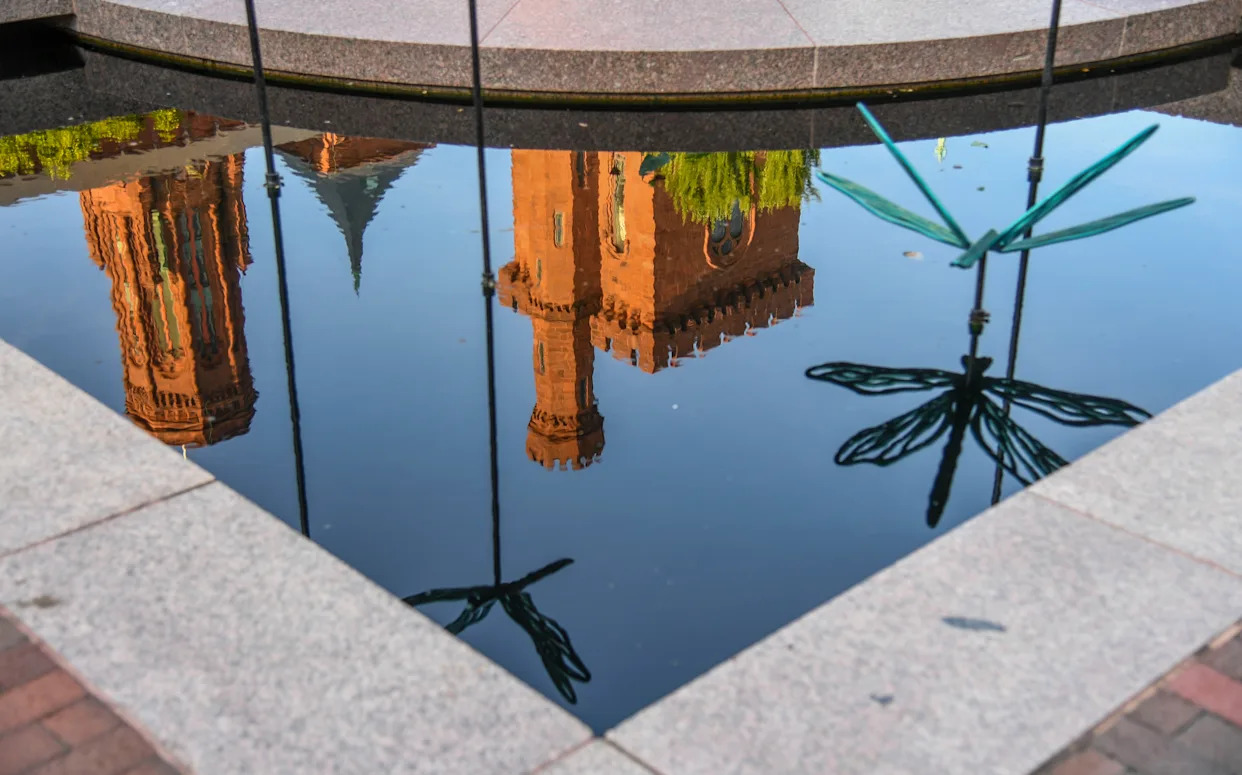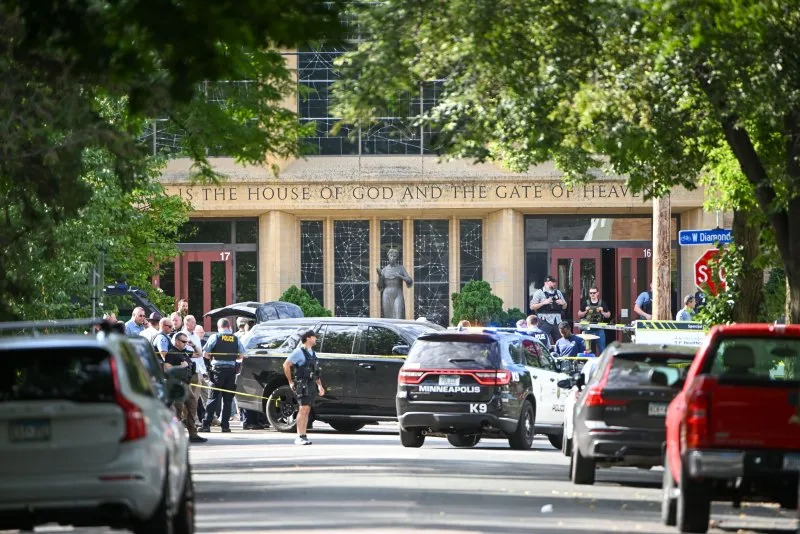
When the White House posted an article condemning a long list of Smithsonian content last week, it pointed to several specific artworks, a sampling that underlined the kind of material that could be targeted by a president who is increasingly interested in influencing what Americans see in public museums.
The list also criticized Smithsonian exhibition texts, learning materials, past performances and the institution for previously flying the intersex-inclusive Pride flag. This month, President Donald Trump said White House officials were conducting a review of the Smithsonian Institution - months after he signed an executive order seeking to root out “anti-American ideology” in the museum and research complex, an effort that experts say would amount to censorship.
The pieces are an eclectic bunch, united mainly by the Trump administration’s public criticism of them. Not all the artworks are currently on view at the museums. Taken together, they tell a story of a White House that is sensitive to imagery that appears to contradict its messaging, whether it shows a transgender woman cast as the Statue of Liberty or a boy peering over the Southern border.
“Taxpayer money should not be used for things that pit Americans against one another,” White House spokesperson Davis Ingle said in an email last week. “Our Smithsonian should exhibit history in an accurate, honest, and factual way.”
To Trump, the artworks might exemplify how imagery found across the Smithsonian is too “woke,” “downtrodden” and backward-looking, as he articulated in a post on Truth Social this month. To the artists, they capture an American story that goes beyond a single narrative.
Here is a look at the artworks named by the White House as evidence that Trump is “right” about the Smithsonian - and how several of the artists have responded.
- - -
Immokalee Statue of Liberty
In 2000, a group of farmworkers had six miles left of a 234-mile march from Fort Myers, Florida, to Orlando when police took away their traffic lane. The Coalition of Immokalee Workers, comprised largely of Mexican, Haitian, Mayan and Guatemalan immigrants, could continue their demonstration for fair wages on the sidewalk - but they would need to leave behind the giant papier-mâché Statue of Liberty guiding them on a truck.
With brown skin and a basket of tomatoes, the sculpture is far from the Greco-Roman likeness that Americans know as the Statue of Liberty. She is meant to be a more than 10-foot-tall reminder of who puts food on tables, a symbolic portrait of the workers themselves and a visual refrain of the line once on the sculpture’s pedestal: “I, too, am America.” She’s also heavy - some 200 pounds, by artist Kat Rodriguez’s estimate. But that didn’t stop the farmworkers, who pried her off the pedestal and carried her to the end of the march on their backs.
Rodriguez, who is now based in Colorado, wasn’t entirely surprised when the piece, now at the Smithsonian’s National Museum of American History in its “Many Voices, One Nation” exhibit, appeared on the White House list. They’re “coming after the people that speak the most truth,” she said. Still, she’s “disheartened to see this intentional and strategic attempt to erase stories, to rewrite reality, and to invalidate where people came from and how they got there.”
When Rodriguez last saw the sculpture, surrounded by a group of women taking a selfie, it brought her to tears. “A lot of times, if I walk into a museum, I don’t necessarily see my own skin tone or my own face,” she told The Washington Post. Not then. When she bought the sculpture’s paint years ago, she recalls, “I held out my arm, and I said, ‘I want this paint color.’”
- - -
‘4th of July From the South Border’
When Manhattan-based artist Felipe “Feggo” Galindo heard from a friend that his 1999 piece “4th of July From the South Border” was included in the White House’s list, he felt a mix of shock, fear and confusion. It is shown in “¡Presente! A Latino History of the United States,” an exhibition previewing the forthcoming National Museum of the American Latino.
“I am feeling vulnerable too… Is this what the artists in the Hitler days felt when their works were labeled ‘Degenerate Art’?” Galindo wrote in a recent post on Instagram.
Galindo noted that the artwork doesn’t promote an “open borders narrative,” as a story from the right-wing publication the Federalist, cited in the White House’s list, suggests. It shows a boy admiring Fourth of July fireworks through an American-flag-shaped fence on the U.S.-Mexico border, wishing he could be in the States.
“It’s not easy to see the images of detentions and creating conditions for families to be separated,” Galindo told The Post, explaining that artists inherently take on complex issues. “In these problems, I always say, ‘Don’t shoot the messenger.’”
“I think art is very powerful,” he added. “It’s a powerful voice, and we artists try to do our best to create dialogue and contribute to the communities’ different points of view.”
- - -
‘Refugees Crossing the Border Wall Into South Texas’
A calm prevails in the work of Rigoberto A. González, who embraces an orderly baroque-inspired style, using accentuating lighting and strong diagonals. In González’s 2020 piece, the refugees are far from the invaders Trump has described. Here, they’re represented by a woman, clutching a plump baby and what appears to be a rosary; a man with hope and fear dueling in his eyes; and a boy, who appears to be simultaneously clinging to and trying to protect his father.
The piece is “not promoting immigration,” González told The Post last week. “It’s the reality of immigration - and the fact that when immigrants come here, they don’t always find this American Dream that they’re supposedly chasing.”
- - -
‘Trans Forming Liberty’
The way Arewà Basit became the Statue of Liberty in an Amy Sherald portrait was really mere improvisation. Sherald was photographing Basit when the model and musician “struck a pose with my hand on my hip, just being me,” Basit said. Sherald threw her a paper towel roll, and Basit raised it in the air. “It literally was like we found the Statue of Liberty in the moment together,” she said.
The moment was crystallized in a Sherald portrait of Basit, a trans woman, that saw a surge in attention when the National Portrait Gallery clashed with the artist over how to include it in an exhibition of Sherald’s work scheduled for the museum - prompting Sherald to pull out last month.
To Basit, the portrait is a reclamation. She had taken the Pledge of Allegiance especially seriously growing up Texas, where she learned it in both Spanish and English. “I was a very earnest kid,” she recalls. “I remember telling myself, ‘This must be so important if everybody wants us to know it in these languages.’” Over time, Basit’s feelings changed as she came to understand her gender and saw how the pledge “only seems to mean a lot to people who actually are afforded equal rights in this world.”
To Trump’s team, Sherald’s piece recasts the monument through a “divisive and ideological lens.” Yet to represent Lady Liberty as someone else could also be seen as her truest form - shape-shifting in the eyes of her beholder, be it an immigrant arriving in the United States or a pink-haired trans woman. For Basit, rather than divide, the portrait expands, showing that “we don’t need anyone else to validate that ‘Liberty and justice for all’ for us,” she said. “We can validate it for ourselves.”
- - -
‘My Dreams Are Not Illegal’
Yocelyn Riojas’s bright illustration appears on the Trump list with no context. It shows a longhaired Afro-Latina woman against a sky-blue backdrop, speckled with monarch butterflies.
Riojas, a Mexican American artist whose work “celebrates border culture,” made the drawing in 2017, on the morning that the first Trump administration announced that the Deferred Action for Childhood Arrivals (DACA) program would expire. It spread widely on social media and eventually found its way to the exhibition previewing the National Museum of the American Latino.
“I would never have imagined in my dreams that this image would represent such a strong message or reach so many people nationally,” Riojas said in a 2022 post. “I’m proud and honored to be part of this time in history.”
- - -
‘From the Deep: In the Wake of Drexciya’
Ayana V. Jackson’s recent exhibition at the Smithsonian National Museum of African Art depicts Drexciya, a mythical underwater world, invented by an electronic music band of the same name, that is populated by the children of enslaved pregnant women who were thrown or jumped overboard while crossing the Middle Passage. The idea of Drexciya is seen as an example of Afrofuturism, the term coined in the 1990s to describe Black science fiction and speculative art highlighting themes of possibility and technological progress.
The show, which closed this year, included photographs, costumes and videos illustrating that alternate realty. Jackson became a certified divemaster to film vignettes exploring the ocean’s depths; throughout the show, she casts herself as characters from Drexciya, donning elaborate, Elizabethan-inspired costumes with a nautical flair.
While Trump criticized the Smithsonian for being too negative, Jackson’s exhibit, which was on the list, offers something more nuanced. In a video, she described the works as bringing “a site of annihilation to a realm of possibility.”
- - -
‘A Portrait of Dr. Anthony Fauci’
Hugo Crosthwaite told The Post last week that appearing on Trump’s list was a kind of honor. He added Monday that he suspects his Anthony S. Fauci portrait was included by the White House because it “gives dimension to one of the most unlikely public figures of our day,” and one who is “regarded in the highest esteem by some and vilified by others.”
The animated portrait, which was commissioned by the National Portrait Gallery, captures that division, showing the former director of the National Institute of Allergy and Infectious Diseases wearing devil horns in one frame and donning a crown in the next. But the piece also depicts the social unrest around the coronavirus pandemic and HIV/AIDS epidemic. In several frames, patients suffering from disease appear in the center, surrounded by a tableau of grieving, anguished faces that look fit for a dramatic history painting. In other sections, protesters are crowded into compositions evoking Mexican muralism.
The piece captures “the politics of both eras, where government and health policy were often at odds with each other,” Crosthwaite said, adding a note of caution: “We are condemned to repeat terrible mistakes if we can’t objectively look at our history.”
Related Content
Tariffs push small and midsize toy companies into survival mode
As Trump tightens grip on D.C., officers say their chief is absent







Comments